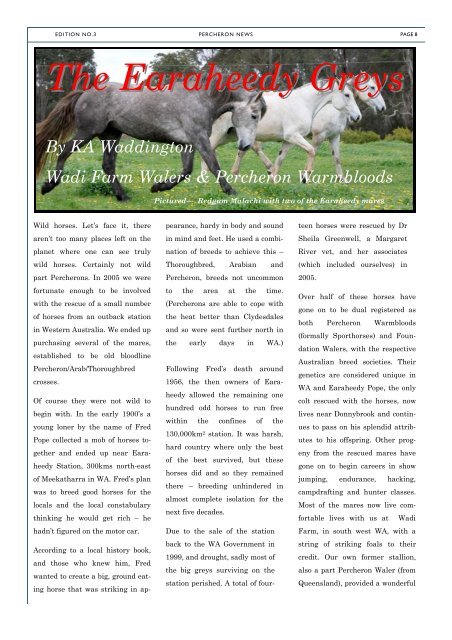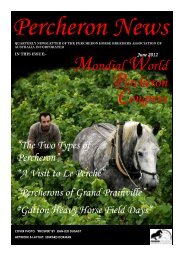to view the newsletter - Percheron Horse Breeders Association of ...
to view the newsletter - Percheron Horse Breeders Association of ...
to view the newsletter - Percheron Horse Breeders Association of ...
You also want an ePaper? Increase the reach of your titles
YUMPU automatically turns print PDFs into web optimized ePapers that Google loves.
EDITION NO.3<br />
PERCHERON NEWS<br />
The Earaheedy Greys<br />
By KA Wadding<strong>to</strong>n<br />
Wadi Farm Walers & <strong>Percheron</strong> Warmbloods<br />
Wild horses. Let’s face it, <strong>the</strong>re<br />
aren’t <strong>to</strong>o many places left on <strong>the</strong><br />
planet where one can see truly<br />
wild horses. Certainly not wild<br />
part <strong>Percheron</strong>s. In 2005 we were<br />
fortunate enough <strong>to</strong> be involved<br />
with <strong>the</strong> rescue <strong>of</strong> a small number<br />
<strong>of</strong> horses from an outback station<br />
in Western Australia. We ended up<br />
purchasing several <strong>of</strong> <strong>the</strong> mares,<br />
established <strong>to</strong> be old bloodline<br />
<strong>Percheron</strong>/Arab/Thoroughbred<br />
crosses.<br />
Of course <strong>the</strong>y were not wild <strong>to</strong><br />
begin with. In <strong>the</strong> early 1900’s a<br />
young loner by <strong>the</strong> name <strong>of</strong> Fred<br />
Pope collected a mob <strong>of</strong> horses <strong>to</strong>-<br />
ge<strong>the</strong>r and ended up near Eara-<br />
heedy Station, 300kms north-east<br />
<strong>of</strong> Meekatharra in WA. Fred’s plan<br />
was <strong>to</strong> breed good horses for <strong>the</strong><br />
locals and <strong>the</strong> local constabulary<br />
thinking he would get rich – he<br />
hadn’t figured on <strong>the</strong> mo<strong>to</strong>r car.<br />
According <strong>to</strong> a local his<strong>to</strong>ry book,<br />
and those who knew him, Fred<br />
wanted <strong>to</strong> create a big, ground eat-<br />
ing horse that was striking in ap-<br />
Pictured— Redgum Malachi with two <strong>of</strong> <strong>the</strong> Earaheedy mares<br />
pearance, hardy in body and sound<br />
in mind and feet. He used a combi-<br />
nation <strong>of</strong> breeds <strong>to</strong> achieve this –<br />
Thoroughbred, Arabian and<br />
<strong>Percheron</strong>, breeds not uncommon<br />
<strong>to</strong> <strong>the</strong> area at <strong>the</strong> time.<br />
(<strong>Percheron</strong>s are able <strong>to</strong> cope with<br />
<strong>the</strong> heat better than Clydesdales<br />
and so were sent fur<strong>the</strong>r north in<br />
<strong>the</strong> early days in WA.)<br />
Following Fred’s death around<br />
1956, <strong>the</strong> <strong>the</strong>n owners <strong>of</strong> Eara-<br />
heedy allowed <strong>the</strong> remaining one<br />
hundred odd horses <strong>to</strong> run free<br />
within <strong>the</strong> confines <strong>of</strong> <strong>the</strong><br />
130,000km 2 station. It was harsh,<br />
hard country where only <strong>the</strong> best<br />
<strong>of</strong> <strong>the</strong> best survived, but <strong>the</strong>se<br />
horses did and so <strong>the</strong>y remained<br />
<strong>the</strong>re – breeding unhindered in<br />
almost complete isolation for <strong>the</strong><br />
next five decades.<br />
Due <strong>to</strong> <strong>the</strong> sale <strong>of</strong> <strong>the</strong> station<br />
back <strong>to</strong> <strong>the</strong> WA Government in<br />
1999, and drought, sadly most <strong>of</strong><br />
<strong>the</strong> big greys surviving on <strong>the</strong><br />
station perished. A <strong>to</strong>tal <strong>of</strong> four-<br />
teen horses were rescued by Dr<br />
Sheila Greenwell, a Margaret<br />
River vet, and her associates<br />
(which included ourselves) in<br />
2005.<br />
PAGE 8<br />
Over half <strong>of</strong> <strong>the</strong>se horses have<br />
gone on <strong>to</strong> be dual registered as<br />
both <strong>Percheron</strong> Warmbloods<br />
(formally Sporthorses) and Foun-<br />
dation Walers, with <strong>the</strong> respective<br />
Australian breed societies. Their<br />
genetics are considered unique in<br />
WA and Earaheedy Pope, <strong>the</strong> only<br />
colt rescued with <strong>the</strong> horses, now<br />
lives near Donnybrook and contin-<br />
ues <strong>to</strong> pass on his splendid attrib-<br />
utes <strong>to</strong> his <strong>of</strong>fspring. O<strong>the</strong>r prog-<br />
eny from <strong>the</strong> rescued mares have<br />
gone on <strong>to</strong> begin careers in show<br />
jumping, endurance, hacking,<br />
campdrafting and hunter classes.<br />
Most <strong>of</strong> <strong>the</strong> mares now live com-<br />
fortable lives with us at Wadi<br />
Farm, in south west WA, with a<br />
string <strong>of</strong> striking foals <strong>to</strong> <strong>the</strong>ir<br />
credit. Our own former stallion,<br />
also a part <strong>Percheron</strong> Waler (from<br />
Queensland), provided a wonderful



